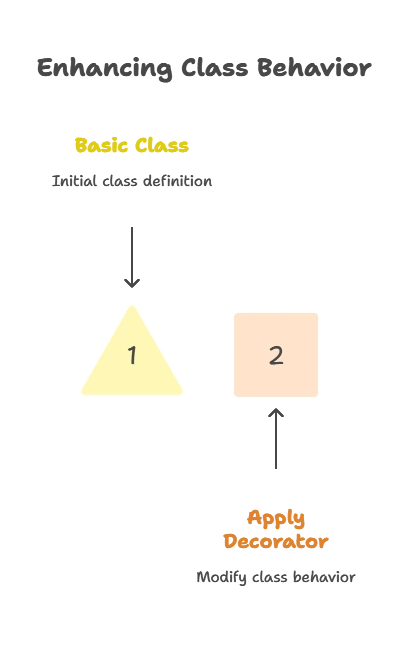Class Decorators
Class decorators are a powerful feature that allow you to modify or enhance the behavior of classes in Python. In this topic, we will explore class decorators comprehensively, starting from the basics and gradually moving towards more advanced concepts.
Understanding Class Decorators
In this section, we’ll cover the fundamentals of class decorators and how they work in Python.
What are Class Decorators?
Class decorators are similar to function decorators, but instead of modifying individual functions, they modify entire classes. They allow you to add functionality to classes without changing their code directly.
Why are Class Decorators Important?
Class decorators provide a powerful way to modify the behavior of classes, such as adding additional methods or attributes, enforcing constraints, or implementing design patterns.
Syntax of Class Decorators
The syntax for using class decorators involves prefixing the decorator with the @ symbol before the class definition.
def decorator(cls):
# Modify or enhance the class here
return cls
@decorator
class MyClass:
pass
Explanation:
- In this example,
decoratoris a class decorator that takes a classclsas input, modifies or enhances it, and returns the modified class. The@decoratorsyntax is used to apply the decorator to theMyClassclass.

Creating Class Decorators
In this section, we’ll explore different approaches to creating class decorators and how to use them in various scenarios.
Simple Class Decorators
Simple class decorators are implemented as regular Python functions that take a class as input and return a modified or enhanced version of the class.
def add_method(cls):
def new_method(self):
return "New method added"
cls.new_method = new_method
return cls
@add_method
class MyClass:
pass
obj = MyClass()
print(obj.new_method())
Output:
New method added
Explanation:
- In this example, the
add_methodclass decorator adds a new methodnew_methodto theMyClassclass. When an instance ofMyClassis created, it can call thenew_methodmethod.
Class Decorators with Arguments
Class decorators can also take arguments, allowing for customization of their behavior based on the provided arguments.
def add_attribute(attr_value):
def decorator(cls):
cls.new_attribute = attr_value
return cls
return decorator
@add_attribute("Hello")
class MyClass:
pass
print(MyClass.new_attribute)
Output:
Hello
Explanation:
- In this example, the
add_attributeclass decorator takes an argumentattr_valueand adds a new attributenew_attributewith the specified value to theMyClassclass.
Advanced Class Decorator Concepts
In this section, we’ll delve into more advanced concepts related to class decorators, including chaining decorators, parameterized decorators, and handling decorator arguments.
Chaining Class Decorators
Similar to function decorators, class decorators can also be chained together to modify the behavior of a class in multiple ways.
def uppercase_methods(cls):
for name, value in vars(cls).items():
if callable(value):
setattr(cls, name, lambda self, *args, **kwargs: value(self, *args, **kwargs).upper())
return cls
def add_prefix(prefix):
def decorator(cls):
for name, value in vars(cls).items():
if callable(value):
setattr(cls, name, lambda self, *args, **kwargs: prefix + value(self, *args, **kwargs))
return cls
return decorator
@add_prefix("Hello ")
@uppercase_methods
class MyClass:
def __init__(self, name):
self.name = name
def greet(self):
return f"Hi, {self.name}"
obj = MyClass("John")
print(obj.greet())
Output:
HELLO HI, JOHN
Explanation:
- In this example, the
uppercase_methodsclass decorator converts the return value of all methods in the class to uppercase, while theadd_prefixclass decorator adds a prefix to the return value of all methods. When applied to theMyClassclass, both decorators are chained together, resulting in methods that return uppercase greetings with a prefix.
Parameterized Class Decorators
Parameterized class decorators allow you to customize the behavior of decorators by passing arguments to them.
def repeat_methods(n):
def decorator(cls):
for name, value in vars(cls).items():
if callable(value):
setattr(cls, name, lambda self, *args, **kwargs: value(self, *args, **kwargs) * n)
return cls
return decorator
@repeat_methods(3)
class MyClass:
def __init__(self, name):
self.name = name
def greet(self):
return f"Hi, {self.name}"
obj = MyClass("John")
print(obj.greet())
Output:
Hi, JohnHi, JohnHi, John
Explanation:
- In this example, the
repeat_methodsclass decorator takes an argumentnand repeats the return value of all methods in the classntimes. When applied to theMyClassclass with@repeat_methods(3), all methods in the class will return their result repeated three times.
In this comprehensive exploration, we've explored the powerful world of class decorators in Python. Class decorators provide a versatile and flexible way to modify or enhance the behavior of classes, allowing for greater code reusability and modularity. Class decorators are a fundamental aspect of Python programming and are widely used in many libraries and frameworks. They offer a clean and elegant solution to extend the functionality of classes without directly modifying their source code. By mastering class decorators, you can write more concise, modular, and maintainable code, leading to improved productivity and code quality. Happy Coding!❤️
